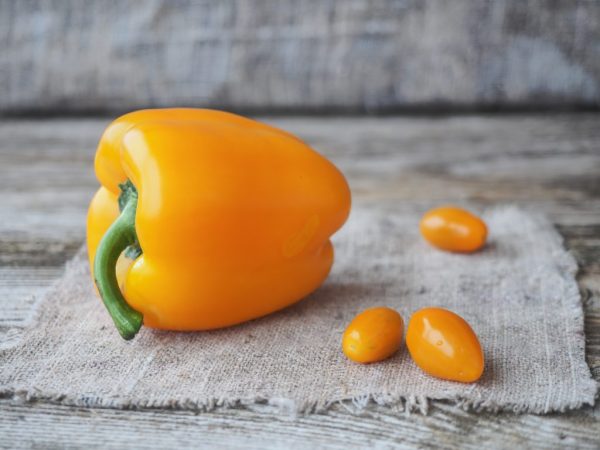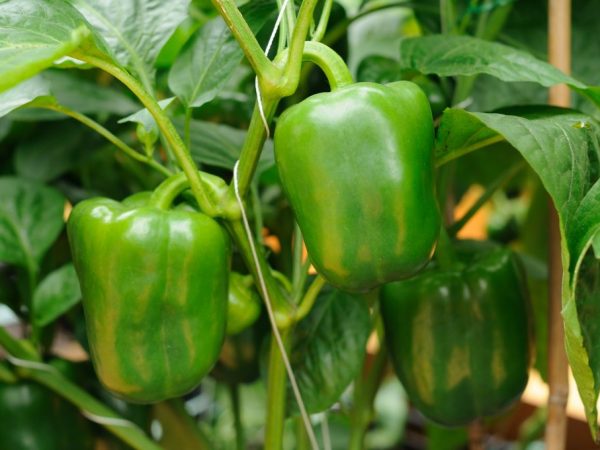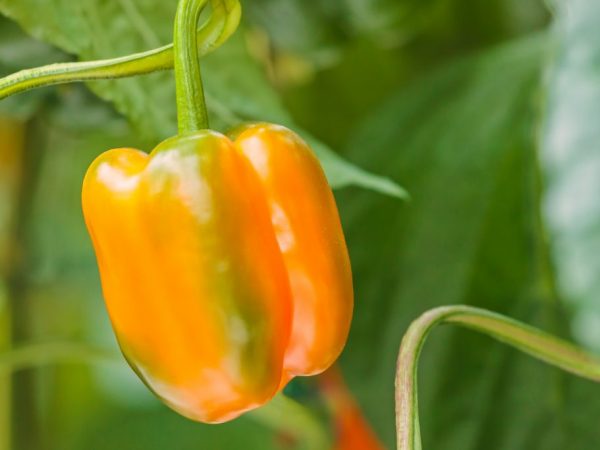Characteristics of the Big Mama pepper variety
Big Mama sweet pepper is quite popular among other types of bell peppers. The variety was bred about 7-8 years ago.

Characteristics of the Big Mama pepper variety
Variety characteristic
The Big Mama variety is grown both in an open area and under cover. Fruits differ in taste, are useful and versatile in use.
The species belongs to the early maturing, the fruits ripen 120 days after planting the seeds. Due to their orange color, the fruits contain many useful substances:
- Vitamin A. It contributes to the proper functioning of the immune system. Good for eyesight.
- Vitamin C. With its help, iron is well absorbed. This helps in the restoration of blood vessels.
- Phosphorus. It promotes the growth of bones, teeth, muscle tissue, and takes an active part in metabolism.
- Potassium. It controls the nervous system, is responsible for the regulation of water balance in the body.
The main advantage of this vegetable is its high yield. From 1 sq. m under the shelter, about 7 kg of the crop are harvested.
Big Mama fruits have good transportability and cold resistance. When the temperature drops, the culture does not stop growing and developing.
Description of bushes
The root system of plants is well developed. The stems are stable but easily damaged.
One of the main characteristics is its height. The growth of Big Mama bushes reaches 60-70 cm. In the greenhouse, they grow up to 100 cm. At this height, the plants require a garter to the supports. The leaves are small, with a smooth surface, dark green.
Description of fruits
The shape of the vegetable is like a cylinder, slightly flattened on the sides. According to the characteristics, the surface of the fruit is smooth, with a pronounced shine, slightly ribbed on the sides. The color of the peppercorns is bright orange, in the period of incomplete maturity - dark green.
The fruits grow quite large. Their average weight is about 120-150 g. It happens that the fruits reach 200 g.
According to the description, the pulp of the Big Mama pepper is juicy and fleshy. The walls are quite thick - about 7-8 mm.
Growing rules
Big Mama sweet pepper needs high-quality care and timely weeding, since it helps to accelerate the development of the plant and is a prophylaxis against pests.
In the southern regions, Big Mama bell pepper is grown in seedlings. Seeds are planted at the end of February, if the sprouts are then transplanted into the greenhouse. At the opening, the site is planted at the end of March.
Seeds need:
- a lot of light (the first 6 days around the clock);
- constant warmth;
- moderate watering.
Seeds sprout in 7-10 days. To make this happen faster, they are soaked for a couple of hours in any means to stimulate growth. As home remedies, use aloe juice or a mixture of honey and water in equal parts.

Treatment with stimulants increases plant immunity
There are growth stimulants that can be purchased at garden stores:
- "Zircon". This drug regulates the growth and development of the root system of the plant, helps the crop to be more resistant to diseases.For watering, use 10 drops of the drug per 1 liter of water.
- Novosil. It accelerates the growth of bushes, increases fertility, increases the growth of the root system. This agent in the form of an aqueous emulsion is used when sowing grains.
- Epin. This drug contributes to the development of resistance in vegetable crops to different weather conditions: drought, frost, strong temperature extremes. Crops treated with this product yield a yield 10-15% higher than the average.
Transfer
Sweet peppers Big Mama are transplanted 60-80 days after sowing the seeds, when the stems reach 20 cm and have 8-12 leaves. It is planted according to the 30 by 50 cm scheme. The main thing in this procedure is the choice of the correct depth, since the plant does not tolerate strong deepening.
It is good to plant a vegetable in a garden where such vegetable crops grew last season as:
- cabbage;
- squash;
- pumpkin;
- peas.
A crop planted after potatoes or tomatoes is highly susceptible to diseases and pests. Also, pepper and does not tolerate the neighborhood with cucumbers.
Care
Watering
Big Mama sweet peppers do not tolerate drought. It is better to plant seedlings in rainy weather, otherwise the plants will not be accepted.
After planting, the plant is watered 2 times a day, morning and evening. On hot sunny days, it is not worth watering: the rays passing through the water droplets burn the leaves.
During fruiting, the vegetable needs special care. If you do not give him enough water, the fruits will lose their presentation, dry out and become small.
It is also not worth pouring water on the plant: moisture attracts slugs.
Top dressing
Top dressing is needed starting from the seedling period, when the first 2 leaves have already appeared on the plant. The soil is fertilized with a urea solution. It will need 5 liters of water, 0.5 tsp. urea and 2.5 ml of sodium.

Plants need regular fertilization
The next feeding is carried out on the 10th day after the first, when 5 leaves have already appeared on the bushes. For feeding, dissolve 0.5 tsp in water. urea and 1 tsp. potassium monophosphate.
You can also use microfertilizers:
- "Ideal". Fertilization has a good effect on the growth of seedlings and promotes quick adaptation after transplanting. To fertilize the plant at the root, take 10 ml of the drug and dissolve it in 1 liter of water.
- "Aquadon-micro". This preparation significantly increases the yield of fruits. It is most often used for foliar feeding. For the solution, take 100 ml of the drug and dilute it in 10 liters of water.
- Orton-Fe. This tool increases the culture's resistance to various diseases. It also speeds up all metabolic processes. For spraying, use 5 g of the drug and 5 liters of water.
All these microfertilizers are used strictly according to the instructions so as not to harm the culture. In the spring, phosphorus fertilizers are applied to feed the vegetable. They will need 30-40 g per 1 sq. m.
Potash fertilizers are applied with the same calculation. These dressings have a good effect on the growth and development of the root system of the bell pepper.
For the fastest growth, nitrogen fertilizers are used. They need 20-30 g per 1 sq. m. They are used in most cases during the flowering period.
To increase yields, pollinating insects are attracted. To do this, the bushes are sprayed with a solution of 100 g of sugar and 2 g of boric acid. The mixture is diluted in 1 liter of water. When the period of fruit ripening begins, ash is added to the soil (2 tbsp. Per 1 sq. M).
Diseases and pests
Each vegetable crop is prone to different diseases and pests. The Big Mama pepper variety is no exception.
Spider mite
The spider mite is difficult to spot because this small creature hides under the leaves, but the main sign of a tick attack is the bronze or white color on the leaves.
To prevent the negative impact of this pest, the vegetable crop is constantly watered. To fight the mite, plants are sprayed with Malathion. It is a colorless oily liquid.
Aphid
A tobacco solution helps to get rid of this pest. To prepare it:
- take 300 g of tobacco crumbs;
- dissolved in 10 l of water;
- insist 3 days.
The resulting fertilizer is watered in the morning.
When fighting spider mites and aphids, dandelion infusion is used. Take about 300 g of greens and infuse it in warm water for 3 hours. The ready-made product is used to process vegetables during the flowering period.
For prevention purposes, the plant is treated with milk: it repels insects.
Conclusion
The Big Mama sweet pepper variety is popular due to its excellent taste and presentation. To get a good harvest, you need to carry out high-quality planting, watering and feeding. Prevention and control of diseases and pests are especially important.

